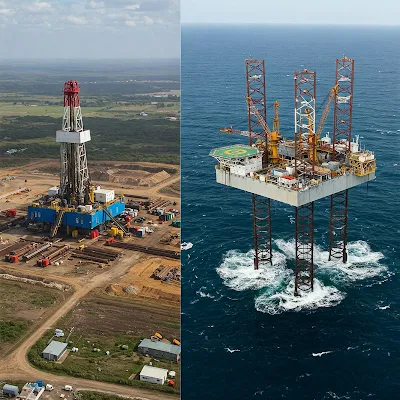The oil and gas industry relies on two primary methods of extracting hydrocarbons: onshore drilling and offshore drilling. While both serve the fundamental goal of energy production, they differ significantly in cost structures, production profiles, and operational challenges. Understanding these differences is crucial for industry professionals, investors, and anyone interested in energy markets.
What is Onshore Drilling?
Onshore drilling refers to oil and gas extraction operations conducted on land. These drilling sites are typically located in oil-rich regions and may include conventional wells, unconventional shale plays, and oil sands extraction.
Pros of Onshore Drilling:
✅ Lower Cost Structure: Onshore drilling projects generally require less capital investment compared to offshore operations. Drilling rigs, infrastructure, and transportation costs are significantly lower.
✅ Easier Access & Logistics: Since operations are on land, transporting equipment, conducting maintenance, and moving workforce personnel is simpler and less expensive.
✅ Faster Drilling & Development: Onshore wells can be drilled and brought online more quickly than offshore wells, making them attractive for companies seeking faster returns.
✅ Lower Risk of Environmental Disaster: While spills and leaks can still occur, onshore drilling is generally easier to manage and contain compared to offshore operations.
Cons of Onshore Drilling:
❌ Land Use & Environmental Concerns: Onshore operations can lead to deforestation, habitat destruction, and conflicts with local communities over land rights.
❌ Limited Reserves & Decline Rates: Many of the world’s largest and most accessible onshore reserves have already been developed, leading companies to seek unconventional reservoirs that may have higher decline rates.
❌ Regulatory & Social Challenges: Onshore projects often face strict regulations, protests, and legal battles over environmental impact and land use.
What is Offshore Drilling?
Offshore drilling involves extracting oil and gas from beneath the seabed. These operations take place in oceans, seas, and deepwater locations, requiring advanced drilling technologies and highly specialized equipment.
Pros of Offshore Drilling:
✅ Access to Large, Untapped Reserves: Offshore fields often contain vast reserves of hydrocarbons, including deepwater and ultra-deepwater reservoirs.
✅ Higher Production Rates: Offshore wells tend to produce higher volumes of oil and gas compared to many onshore counterparts, making them highly profitable in the long run.
✅ Less Land Disruption: Offshore drilling does not require large land footprints, avoiding some of the land-use conflicts seen in onshore operations.
Cons of Offshore Drilling:
❌ High Capital Costs: Offshore drilling requires expensive infrastructure such as floating rigs, subsea production systems, and specialized transport vessels, making it a costly endeavor.
❌ Complex Operations & Safety Risks: Harsh marine conditions, deepwater pressure, and hurricane risks make offshore drilling one of the most challenging sectors in the energy industry.
❌ Environmental Concerns & Oil Spills: Offshore spills can be catastrophic, impacting marine ecosystems and coastlines for years.
Key Differences Between Onshore and Offshore Drilling
| Factor | Onshore Drilling | Offshore Drilling |
|---|---|---|
| Cost | Lower cost, quicker returns | High capital investment, long-term profitability |
| Production Rates | Moderate production rates, often smaller reservoirs | High production rates, large untapped reserves |
| Operational Challenges | Land access issues, regulatory hurdles | Extreme weather, deepwater drilling complexities |
| Environmental Risks | Land degradation, groundwater contamination | Oil spills, marine ecosystem damage |
| Technology Requirements | Standard drilling rigs, hydraulic fracturing | Advanced deepwater drilling, subsea technology |
Which is the Better Choice?
The decision between onshore and offshore drilling depends on multiple factors, including a company’s financial position, risk tolerance, and technological capabilities.
- For quicker, lower-cost projects with manageable risks, onshore drilling is the preferred choice.
- For long-term, high-reward projects with large reserves, offshore drilling can offer significant profitability despite the higher risks and costs.
As the industry continues to evolve, advancements in drilling technologies, automation, and environmental protections will shape the future of both onshore and offshore operations. Whether on land or at sea, oil and gas production remains an essential driver of the global economy.
Stay tuned to Oilfield Intel for more insights on oil and gas trends, drilling technologies, and industry developments!

Comments
Post a Comment